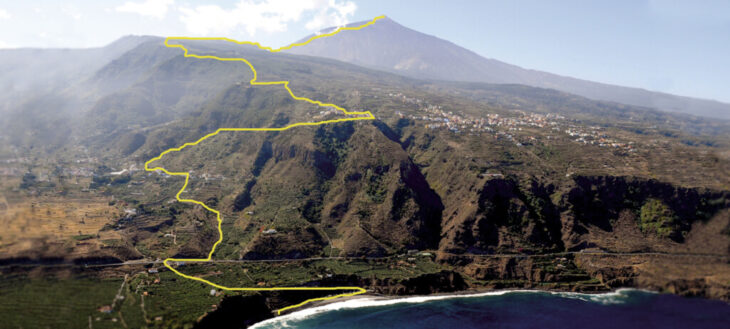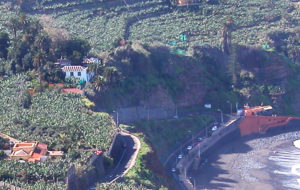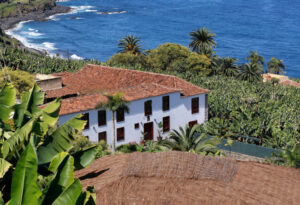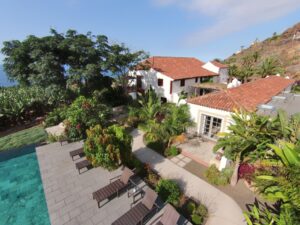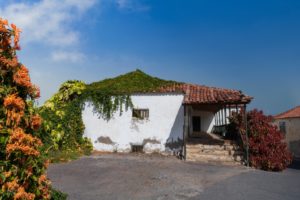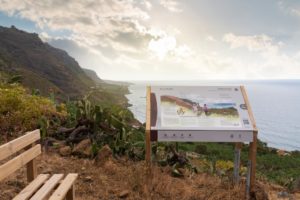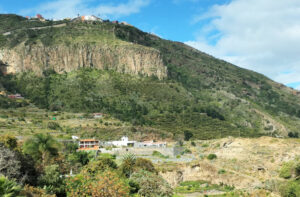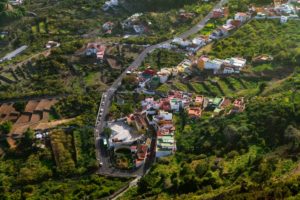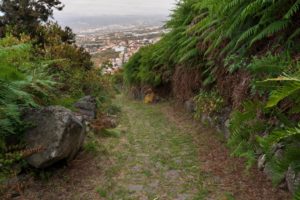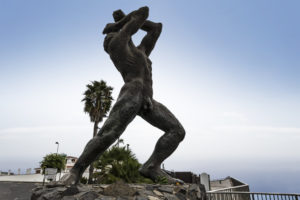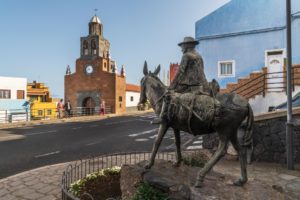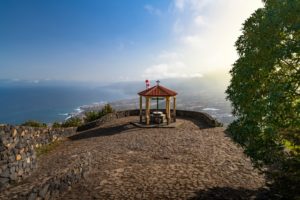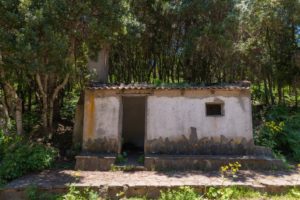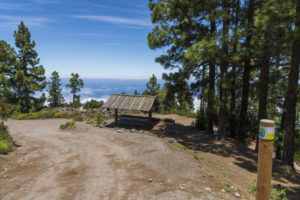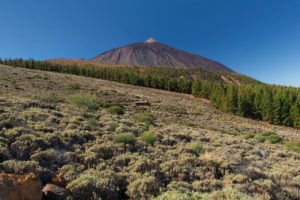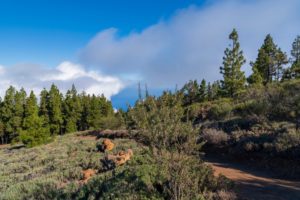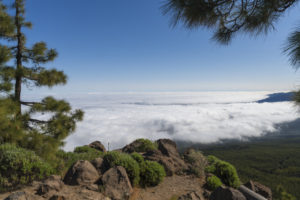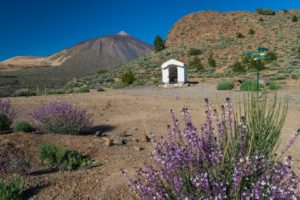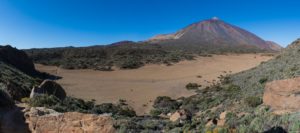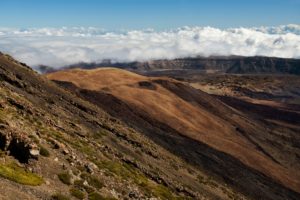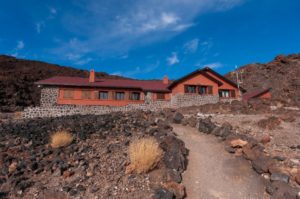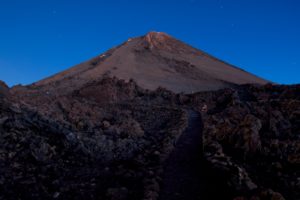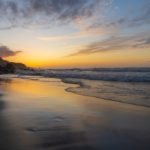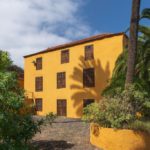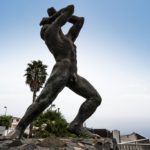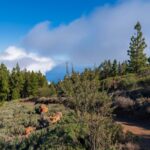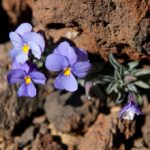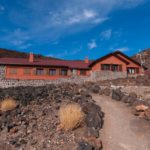Tenerife‘s route 040 is an adventurous trail that reaches the summit of mount Teide, starting from the shore of Socorro beach in the municipality of Los Realejos and returning on the same path until one has once again set foot on the volcanic sand of the beach. It is, without a doubt, the toughest of Teide’s challenges, the third highest volcano on the planet as measured from its base.
Reaching the summit of the Atlantic giant is a huge challenge. But it only finishes once you have returned to sea level again. As those who love mountaineering say: “you’ve only finished the climb once you’ve come back down again.” The powers of evil, a kind of netherworld, which they greatly feared, lay hidden in the interior of Echeyde, which is what the aboriginal Guanches called the volcano, whose image was always surrounded with mystery. In addition to the achievement of this great feat, which with nearly 7,600 meters of accumulated height difference and 54 kilometers of mountainous route, it is the route with the highest orographic height difference in Spain, thus turning the island of Tenerife into an attractive sporting and a destination with cult status.
For experienced runners and properly trained athletes, the route is considered a challenge to be completed in a single day. Many athletes and skyrunners of international renoun have attained it, each season achieving a previously unimaginable new record. For those less prepared in this type of tests, it is recommended to enjoy the route in several stages, completing the phases in two or three days, thus achieving the final goal more comfortably and with equal satisfaction.
In addition, the climatic conditions of the island allow this trail to be done during much of the year, except in winter when Teide is often covered with snow. A unique experience in an amazing place. Route 040 leaves no-one unmoved. Accept the challenge and enjoy it.
Warning
- During the periods from May 5th to June 13th, and from October 2nd to November 30th access to the route 040 from Piedra de Los Pastores to the Teide summit is closed from Monadys to Fridays.
Route Map
Apuntes de interés
Socorro Beach
Socorro beach receives its name from the estate and hermitage that are located on its upper part. This area was a privileged redoubt until first the footpath and later the road was built in the second half of the 20th century. Years later it becomes one of the island’s foremost surfing areas.
The Socorro Estate
In the area of “Babón” lies the estate “Hacienda del Socorro” which is named after the hermitage built to Our Lady of Perpetual Help around 1617. Inside, the full-size statue of the name-giving saint presides over an interesting altarpiece in which the portraits of the founding family appear.
The Estate of the Viscount of Buen Paso
Along the old “Camino de los Morales” (Bramble Road) which is still called by its old name even though nowadays no brambles exist in the area any more, stands the Hacienda which elonged to the viscount of Buen Paso and marquis of San Andrés. It had dwellings for the sharecroppers, gardens, seating areas and the main house with a U-shaped floor plan, inside which is a courtyard which was divided by a wall after the partition was made in 1863.
Haciendas Las Cuatro Ventanas and La Rambla
The house called “Casa de las Cuatro ventanas” (the House with Four Windows) belonged to the Vergara and Hoyo families, and later passed on to the marquis of Celada. The ample architecture with two buildings has windows on the north side and several adjacent structures on the south side. It is currently used as a tourist accommodation.
The hacienda known as La Rambla is made up of a simple set of buildings for the owners and sharecroppers. In the past it had a winery and a cellar, a porch and a large patio. The cultivation of bananas determined the use of the land, as well as the architecture of its infrastructures.
An interesting dragon tree grows here: the “Drago de la Rambla del Mar” whose slender top reaches above a sea of banana trees.
Hacienda Las Chozas and the Guindaste Road
The “Las Chozas” hacienda is an interesting building with a wide wooden gallery and roof tiles, open to the old road of “El Guindaste”, nowadays called “Ramblas del Mar”. It is known to have belonged to the majorat founded by Luís Benítez del Hoyo in 1598. In those days it consisted of several houses, winery and a water reservoir. It extended from the cliffs down to the ocean.
Boliche Ridge
Since ancient times, the inhabitants of the area have called this hill between the ravines of Quinto or Barroso and that of Barbuzanos, El Boliche. The place name has endured over the centuries and from generation to generation. In addition, the neighbours who lived in that area took it as a family nickname.
The Hamlet of The Cave
In the lower part of the Tigaiga district lies this hamlet that takes its name from the nearby caves. The old bramble path that connected Tigaiga and the Rambla area used to run through here. Some of the old buildings still exist, some of them transformed into new homes.
Tigaiga
The district of Tigaiga invites you to visit some of its old houses, such as the Casa de La Era, La Cantera or La Coronela, its chapels and the hermitage of Our Lady of Immaculate Conception, founded in 1617, next to the Hacienda De La Fuente. A few metres from the hermitage, is the old Tigaiga laundry area, declared of public utility in 1701.
Three festivals take place in Tigaiga throughout the year: the Living Nativity Scene, which is more than forty years old, the festival of San Antonio Abad, in mid January, and the festivities in honour of the patron saint, Our Lady of the Immaculate Conception, on the first Sunday of September.
The Hacienda La Coronela is worth mentioning, due to the stories about it, where during the wee hours noises and cries could be heard from its halls and corridors. This emblematic building is located very close to the sawmill along the path that goes to Lomito Vaso, also called Camino Nuevo. It intersects, on the left, with Calle La Paz, famous for the traditional puff pastry cakes that are made at Pastelería Paula, with a tradition inherited from the Montijo family since 1889.
The Sawmill
The Sawmill receives the name of an old place for the treatment of wood that was located at this point. A stone with initials testifies to the site. Very close to there, was the shop of María la Chacona, a fundamental milestone on the Camino de Las Vueltas, due to the many stories that occurred there, such as when María placed a white sheet to announce to the neighbors that the Guardia Civil was at her house.
The Road “Camino de Las Vueltas”
The Camino de las Vueltas connects Icod el Alto with Realejo Bajo and was re-built after the entire area was declared a natural reserve. It runs along sedimentary deposits from the slopes with degraded evergreen shrubs and some woodland elements. It is an old road, from the aboriginal times, that linked the menceyato (aboriginal kindom) of Icode with that of Taoro. It was the only way of communication between Icod el Alto and Los Realejos until well into the 20th century.
El Lance Lookout
This is a privileged place, from where we can contemplate the entire Orotava Valley and part of the island’s north. The monumental statute of Mencey Bentor, located in the place from which the Mencey fell, at the beginning of 1496, as a result of the last events that occurred before the conquest of the island, is another of this place’s attractions. In the hamlet of El Lance there was the custom of sounding the “bucio” (a seashell), every time that it became known that an unmarried woman had become pregnant.
Icod el Alto
In aboriginal times it belonged to the menceyato (kingdom) of Icode. After the conquest it was called Icod de los Trigos and later Icod el Alto. Its territory is broken by two ravines, that of Ruiz and that of Dornajo. The La Pared Compulsory Education Center is situated here, which in the 1980s was became germ of the Los Alzados cultural project. An interesting initiative that pursued the recovery of music and traditional life in the area, and which won the Canary Islands Prize for Popular Culture in 2012.
La Corona Lookout
This natural lookout rises above the well-known Risco Blanco, allowing a general view of the entire north of the island of Tenerife. In 1921 a group of hunters who came from the festival of Cruz de la Degollada, stopped to rest here. One of them accidentally fired his shotgun, but none of his companions was injured. In the face of such a miracle, they decided to make a cross and take it in procession from the church of Our Lady of The Immaculate Conception to La Corona, where it was set up. From that moment festivals around the feast of Saint John the Baptist began to be celebrated.
The Fountain of Pedro
The Fountain of Pedro has its origin in an ancient spring, a resting place for those who went up and down from the summit every day. Since 1992, after the supposed appearance of the Virgin Mary in the cave, the site has been quite modified, especially in its vegetation, as invasive species have been planted there and offerings of various kinds have been deposited.
Asomadero
From the Asomadero lookout, located at 1,100 meters of altitude, you can enjoy spectacular views of Teide and the entire La Orotava Valley. An annual mountain race finishes there, that starts from the town of Realejo Alto, and ascends from its base up the steep slopes.
Corral Quemado
There is a wealth of place names that have remained along the road. The so-called Corral Quemado, must have originated from the description of the site itself, since this area was a stop for shepherds that travelled the roads to the summit with their flocks.
The Viera y Clavijo Hut
Since the beginning of the 20th century, a series of refuges for hunters, shepherds and hikers who travelled these areas for diverse reasons, were established in various places of the mountains of Tenerife. These roofed and thick walled constructions, served as shelter against the night, adverse weather conditions or for resting. In this case it receives the name of Los Realejos’ polygraph José de Viera y Clavijo, who among other things popularised nature in his dictionary of natural history in the Canary Islands.
Shepherds’ Boulder
Another of the place name linked to animal herding is known as Shepherds Boulder. A crossing of several forest tracks has distorted the place where the stone formation used to be. It was a mandatory stop in the past for passers-by on their way to the summit, as it was in the pine forest area and near the beginning of the brushland. From here you can access the Los Realejos Forest House, a building constructed in the first half of the 20th century as a dwelling for forest rangers.
The Boulder of La Gallega
The boulder of La Gallega is another of the landmarks of the path to the summit. Among the stories that are told about the place, it was a tradition to deceive the children and youngsters who were going up to Las Cañadas for the first time, telling them that if they got there they could buy sweets at La Gallega’s shop. So the little ones strove to get there and be able to buy sweets. They were rather surprised that what they found in reality were large stones.
La Chapa Apiary
One of the traditional trades linked to the use of the summit is that of beekeeper. It has been common for centuries to take the hives and swarms to the highest areas, especially in spring, when the retama broom bushes are in bloom. The La Chapa apiary is still used as an area for beehives, especially for beekeepers in the municipality of Los Realejos.
La Vega Corral
We continue to find place names linked to shepherding in the area. It used to be very common in past times yet is non-existent today due to various government prohibitions, by which these areas of pasture can no longer be accessed.
Cabezón Lookout
The Tigaiga mountain range closes the La Orotava valley in the west. In its upper part is the Cabezón at 2,172 meters of altitude. In this place we contemplate part of the old volcanic edifice of Las Cañadas, spectacular views of Teide, part of the high altitude forest and the immensity of the Orotava Valley.
Fregel’s Cross
Fregel’s Cross is the Christian symbol at the highest altitude in the municipality of Los Realejos. It has a modest chapel. Since the end of the 19th century lively festivities were celebrated here, organized by the residents of the districts of Icod el Alto, Las Llanadas, Palo Blanco and Tigaiga. These celebrations disappeared in the nineties of the 20th century when these celebrations were restricted within the spaces near the Teide National Park.
La Fortaleza
La Fortaleza (2,190 m. altitude) is constituted as the only vestige that remains of the old Las Cañadas edifice. After its collapse, this steep formation composed of reddish and ocher phonolitic lavas remains. At this point we are at the border with the municipality of San Juan de la Rambla to the west. The flora and fauna of the place are dominated by the Canary pine, cedars and black nightshade, as well as by the common canary, the great spotted woodpecker, and the Tenerife blue chaffinch.
The Guancheros / Degollada Witches’
The names by which this plain is known are related to the human experience of the place, which for centuries was a natural entrance to the Cañadas del Teide. This plain, formed from the sediment of the remains of the eruptions of Montaña Blanca, stands out for its yellowish colour, with small mounds of pumice stone that dot the rugged landscape.
Montaña Blanca
This volcano, that is flat and rounded in shape, is named after the volcanic material that covers it, which is yellowish-white in colour. These tephra are called pumice stone, are of a very light and porous composition, and used for various purposes.
The Mountain Refuge of Altavista
This construction has its origins in the mid-19th century, although it has undergone several
renovations during the following century and the most recent in 2007. It was the accommodation of scientists, travellers, astronomers and geologists, interested in climbing the Pico del Teide and being able to spend some time to investigate its geology or its flora and fauna. It is possible to spend the night in this refuge upon request and payment of the stay, so a reservation must be made on the website.
www.volcanoteide.com/es/volcano_teide/senderismo/refugio_de_altavista
The Rambleta
La Rambleta is the name of the platform that was produced by an ancient crater that was later buried by another eruption of Teide. This terrain was covered by new material, producing a flatter area. This is where the cable car infrastructure was installed in the 1970s.
The Summit
This last part of the great Teide volcano is the Pico, where the crater is located. In this area the socalled fumaroles are frequent: small columns of smoke that rise from ground. The strong smell of sulphur is common, a material that was commercialised a long time ago, mainly for agriculture. With favorable weather conditions, the other Canary Islands and the island of Tenerife can be seen from here. We recommend ascending this last section at dawn to be able to contemplate the sunrise from the Summit.
A BIT OF HISTORY
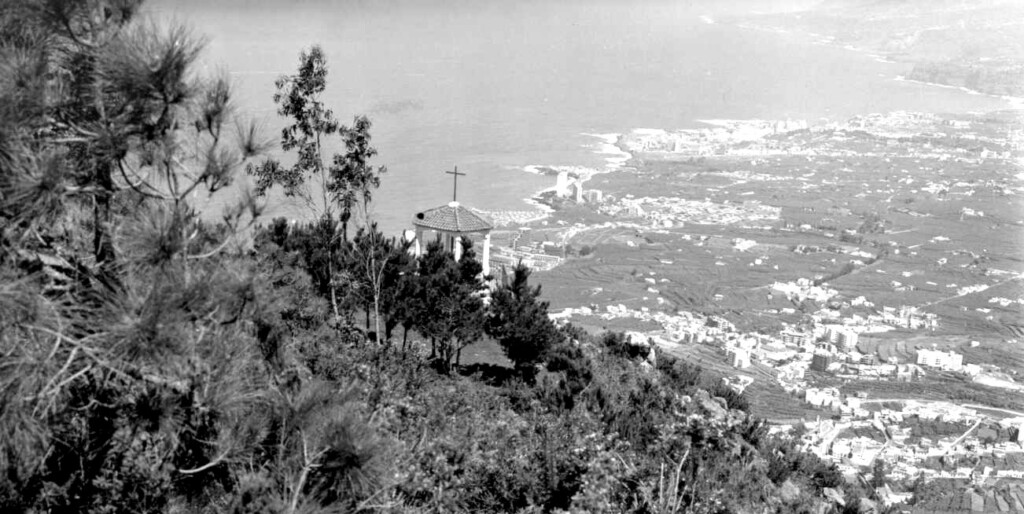
The municipality of Los Realejos, in the north of the island of Tenerife, has a quite remarkable orography. On its territory we find the Tigaiga mountains, a millions of years old massif that closes the Orotava Valley on the west. The trail which boasts the highest cumulative altitude on the island, runs along these steep slopes. A circular route that starts from level 0 on the Socorro beach to climb the Pico del Teide at 3,715 meters of altitude, and descend by the same path, back to the volcanic sand of the coast.
The trajectory of Route 040 is given by various old roads that connected farmsteads and hamlets of the municipality of Los Realejos, as well as others trails that ascended to the area of Las Cañadas and linked with those of the south of the Island. These roads were used for all types of transit: goods, animals and people that went up or down from the highest areas to the coast or vice versa.
Added to this is the interest shown by foreign visitors, since at least the 18th century, to climb Mount Teide and reach its summit. These characters, mostly scientists and naturalists, organized excursions that started from Puerto de la Cruz, passing through Los Realejos, and continue along these old trails that reached Las Cañadas, and from there start the ascent to the summit. There are many written testimonies about these outings that lasted several days, with different stages, many of them full of details and descriptions of places, notes about flora and fauna, as well as the people that accompanied them. It is through these notes that we know how the trail matches the current route 040.
Likewise, during the 20th century, the trail has been improved by different measures carried out by government agencies, such as the former Institute of Nature Conservation ICONA and later the Cabildo de Tenerife and the Canary Islands Government. Most important among them is the building of tracks to facilitate communication in the event of forest fires.
It wasn’t until 2018, though, and given the popularity acquired by the route, when different
institutions projected its improvement and homologation as a trail.
NOTES ABOUT FLORA AND FAUNA
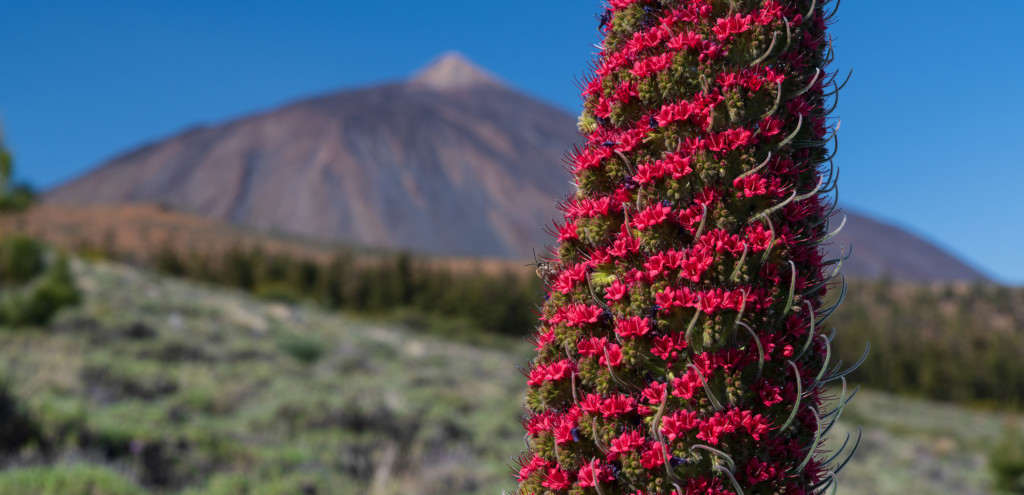
The trajectory of Route 040 takes us into protected natural reserves such as the Rambla de Castro, Tigaiga, Campeches and Ruiz, the Corona Forestal and the Teide National Park, where we can get to know first hand the wealth of the ecosystems and altitudinal zones of the north side of the island of Tenerife..
The rich biodiversity is evident in the multitude of plant and animal species that live in these places, especially on the slopes of Tigaiga, which reach from the cliffs on the coast to El Cabezón in the Teide National Park, where we find authentic relics of our natural heritage.
The summit or high mountain area is the habitat of the Pterocephalus lasiospermus (rosalito de la cumbre), with its striking flowers, the Tenerife blugloss and the retama brooms, as well as an endemic fauna, especially the invertebrate, which goes mostly unnoticed in the lava flows of Las Cañadas del Teide. The National Park, the most visited in Europe, has a rich and varied biodiversity, much of it located between solidified rivers of lava.
The vast expanse of the Corona Forestal is a nesting place for the blue chaffinch, the great spotted woodpecker and the black-headed warbler, which share this space within the mountain shrublands and the laurel forest. In the so-called monteverde, the humidity of the trade winds has maintained this millenary stronghold of species, both plant and animal, that coexist among pines, wild olive trees, persea indica, small-leaved hollies, picconia excelsa, stinkwood and Canary laurels, excellent sources of food for the white tailed laurel pigeons.
In the area of the midlands and where we find the main human settlements, the old thermophilic forests remain as vestiges of larger areas that have now disappeared. In them, junipers, dragon trees and palm trees can be found in the company of clary sage, morning-glory-trees, gold rod trees, tree limonium, dogfennel, Canary Island sorrel and the colourful Canary foxgloves. The fauna is numerous, among which the Tenerife lizard, the partridge, the kestrel and the common canary stand out. On the coast, the balsam spurge and the remains of Canary Islands spurge predominate, along with nesting areas for birds, especially shearwaters.
This natural wealth coexists with a particular cultural heritage that the municipality conserves thanks to a fruitful history that goes back several centuries. Los Realejos boasts with being the most festive town in Spain, with more than eighty festivities throughout the year. In its hamlets and districts, customs linked to the agricultural cycle, gastronomy, oral tradition and folklore are maintained, passed on from generation to generation by a population that has continued to look to its ancestral roots.
To visit the municipality is to enter its midlands; landscapes marked by narrow terraces, which in many cases contrast with extensions on which cereals and “bonita” potatoes are grown. Both products have a deep roots in the high areas of the municipality.
Los Realejos offers many possibilities to learn about its history in its cultural heritage, practice active sports such as paragliding, surfing and bodyboarding, hiking, trail running, or enjoy its festivals and gastronomy.
Route 040 is an example of this, since it allows you to get to know part of that legacy, both cultural and natural, traveling its more than 56 kilometers of trail, starting from the waters of the Socorro beach, ascending Mount Teide to crown it, and going back down again to return to the black sand of our coast.
Route directions
- We start off our hike at sea level on
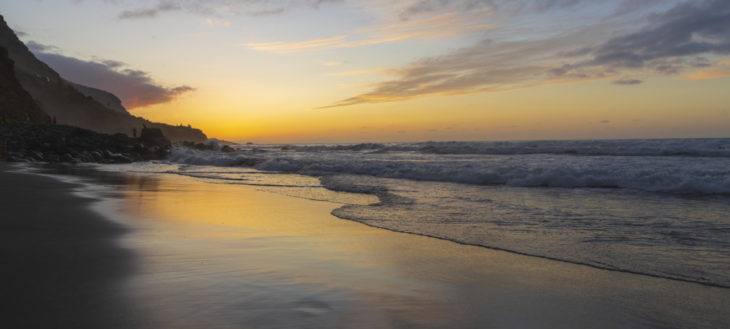 the black sands of Socorro beach. Here we take the road that leads us u to the TF-5 main road and we ascend up to the first crossroads.
the black sands of Socorro beach. Here we take the road that leads us u to the TF-5 main road and we ascend up to the first crossroads. - On the way up, we will leave to our
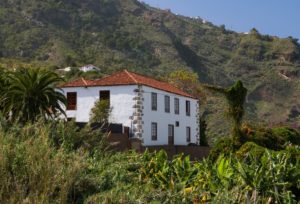 right the Hacienda de las Cuatro Ventanas manor and the crossroads between bananas that allows us to reach the Guindaste natural pools. We pass under the tunnel and cross the road to take the path next to the signpost.
right the Hacienda de las Cuatro Ventanas manor and the crossroads between bananas that allows us to reach the Guindaste natural pools. We pass under the tunnel and cross the road to take the path next to the signpost. - We climb up to the upper part of the
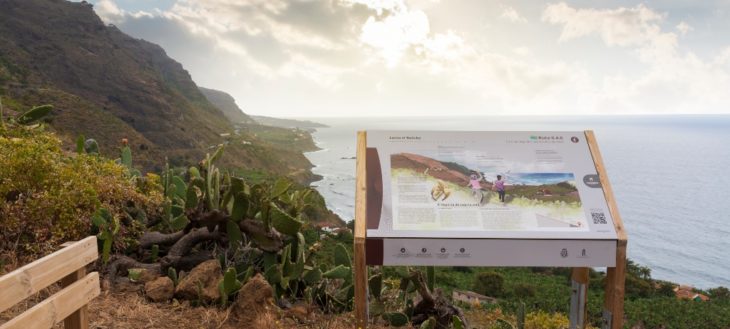 ridge known as “Lomo del Bloliche” where there is a panel with a representation of the views of the Rambla. We walk down to the “La Cueva” road and then continue ascending.
ridge known as “Lomo del Bloliche” where there is a panel with a representation of the views of the Rambla. We walk down to the “La Cueva” road and then continue ascending. - We take the “La Cueva” road and
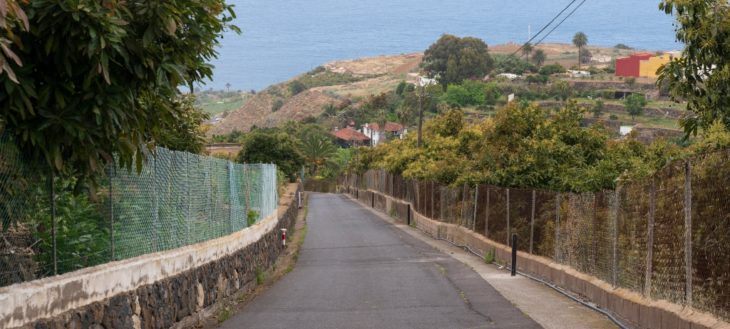 continue ascending a stretch of land until we reach the hamlet. From here we continue on the asphalted road until the intersection.
continue ascending a stretch of land until we reach the hamlet. From here we continue on the asphalted road until the intersection. - At the intersection we turn left,
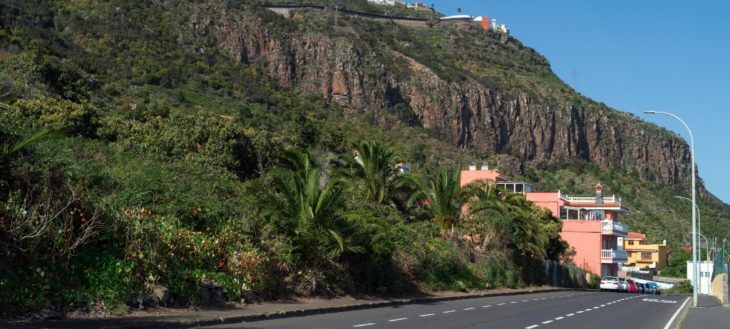 walking a few hundred metres until we reach the intersection with “Camino Las Piedras” to the right.
walking a few hundred metres until we reach the intersection with “Camino Las Piedras” to the right. - We walk up “Camino Las Piedras”
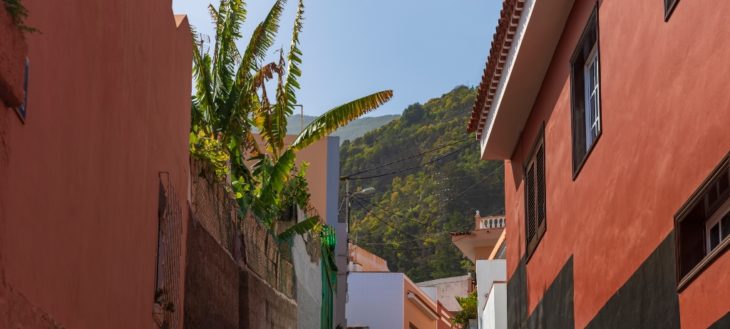 which is asphalted and reach “Calle Tigaiga” at the upper end. There is a well here, where we can refill our water bottles. We now have to turn left.
which is asphalted and reach “Calle Tigaiga” at the upper end. There is a well here, where we can refill our water bottles. We now have to turn left. - We each the sawmill at the
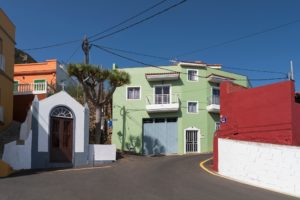 intersection with the chapel of the “Cross of the Sawmill”. Here we turn right and begin the ascent on the old road “Camino de Las Vueltas”.
intersection with the chapel of the “Cross of the Sawmill”. Here we turn right and begin the ascent on the old road “Camino de Las Vueltas”. - The first section of “Camino de las Vuletas” is partly asphalted, partly cemented that ends in a dirt road.
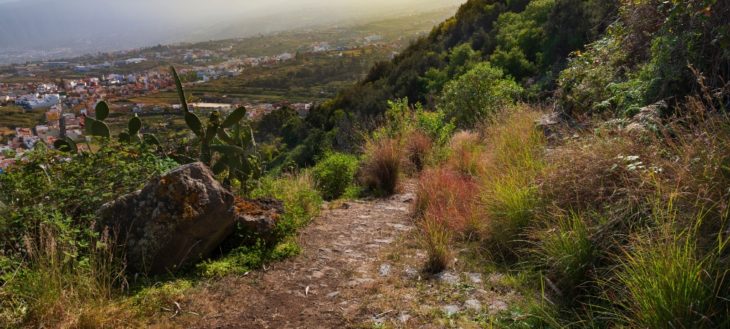 Here we turn right and follow the original route. We walk up a winding, stone paved path until we reach the TF-342 main road.
Here we turn right and follow the original route. We walk up a winding, stone paved path until we reach the TF-342 main road. - On the Icod el Alto general road we
 turn right onto the pedestrian zone that along the edge of the road in direction of the El Lance lookout where we have impressive views of the Orotava Valley and part of the island’s north coast.
turn right onto the pedestrian zone that along the edge of the road in direction of the El Lance lookout where we have impressive views of the Orotava Valley and part of the island’s north coast. - Once past the El Lance viewpoint,
 we will continue along the pedestrian walkway until we see a pedestrian crossing on the left which we must take to go onto “Calle El Lance” street.
we will continue along the pedestrian walkway until we see a pedestrian crossing on the left which we must take to go onto “Calle El Lance” street. - This street has some particularly
 steep sections so we must be very careful, especially if there is traffic.
steep sections so we must be very careful, especially if there is traffic. - After passing through the inhabited
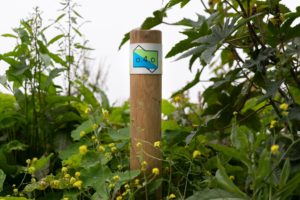 area we reach an agricultural area where we will find the path that will take us to the La Corona lookout.
area we reach an agricultural area where we will find the path that will take us to the La Corona lookout. - From the La Corona outlook we can
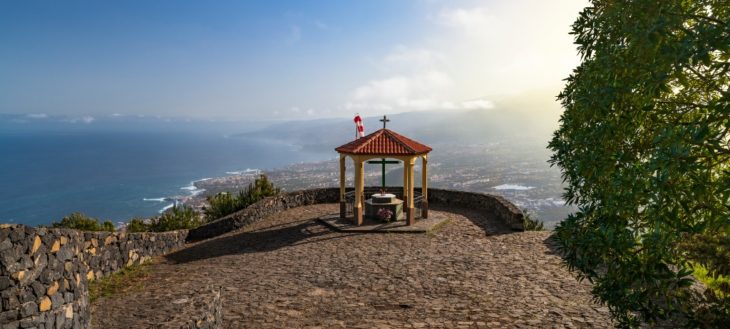 contemplate some of the most beautiful landscapes of the island’s north. We take the trail next to the geodesic mark and next to the parking area until we reach the “Asomadero” without turning from the path. The path goes on being steep and it has slippery stretches.
contemplate some of the most beautiful landscapes of the island’s north. We take the trail next to the geodesic mark and next to the parking area until we reach the “Asomadero” without turning from the path. The path goes on being steep and it has slippery stretches. - From the “Asomedero” lookout,
 situated at 1,100 metres above sea level, we can enjoy spectacular views of mount Teide and the entire Orotava Valley. Several antennae are situated here and the PRTF 40 Trail passes through here, too. We continue our trail in ascent.
situated at 1,100 metres above sea level, we can enjoy spectacular views of mount Teide and the entire Orotava Valley. Several antennae are situated here and the PRTF 40 Trail passes through here, too. We continue our trail in ascent. - A few netres further on we
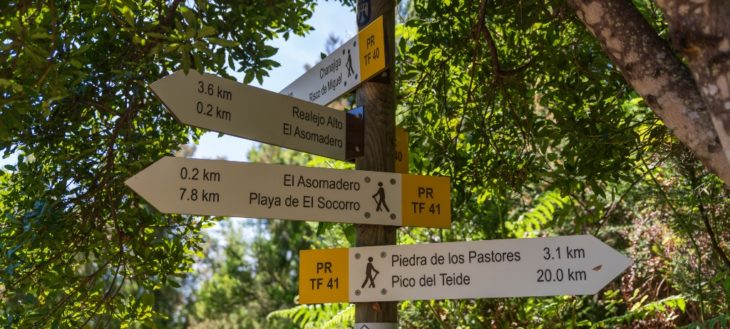 encouter a crossing of several trails: Chanajiga / Pino Llorón / Corral Quemado. We continue upwards without leaving the main trail.
encouter a crossing of several trails: Chanajiga / Pino Llorón / Corral Quemado. We continue upwards without leaving the main trail. - We cross an area of shrubland and
 pine forest with several intersections that we must not use. We reach an area known as “Piedra de los Pastores” (Shepherds’ Stone) and continue along the main trail.
pine forest with several intersections that we must not use. We reach an area known as “Piedra de los Pastores” (Shepherds’ Stone) and continue along the main trail. - We pass the “Piedra de la
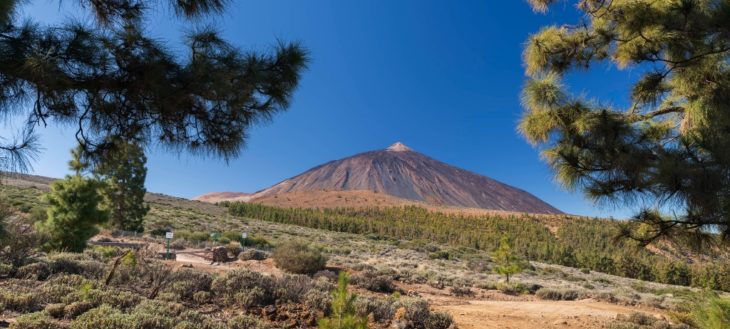 Gallega”, the “Colmenar de la Chapa” and enter the National Park. Crossing the barrier we continue along the main path, turning a curve to the left and taking the path on the right until we reach the lookout of “El Cabezón” an 2,166 metres above sea level.
Gallega”, the “Colmenar de la Chapa” and enter the National Park. Crossing the barrier we continue along the main path, turning a curve to the left and taking the path on the right until we reach the lookout of “El Cabezón” an 2,166 metres above sea level. - We mustn’t leave the main trail
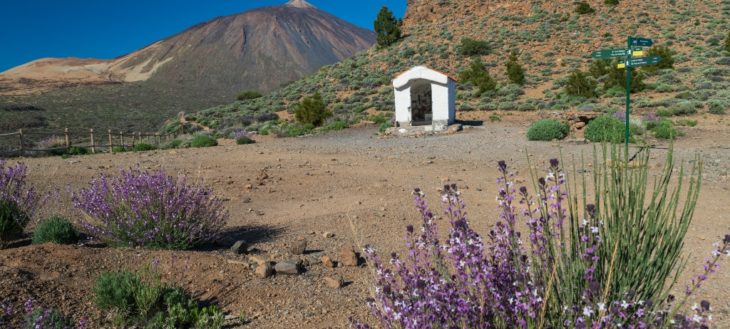 until we reach the foot of the “La Fortaleza” cliffs where we find the Chapel of Fregel or of the “Degollada” (the beheaded). Once we arrive here we continue on a short descent onto the plain.
until we reach the foot of the “La Fortaleza” cliffs where we find the Chapel of Fregel or of the “Degollada” (the beheaded). Once we arrive here we continue on a short descent onto the plain. - One on the plain that bears
 several names: Los Guancheros, de la Degollada, de las Brujas, we turn right onto th emain trail that leads us past a fenced plot of land, to National Park trail number 22 on the left. We cross the whole plain along this trail.
several names: Los Guancheros, de la Degollada, de las Brujas, we turn right onto th emain trail that leads us past a fenced plot of land, to National Park trail number 22 on the left. We cross the whole plain along this trail. - At the end of trail 22 we connect
 with trail number 6 in the area of “Montaña de Los Conejos” (Rabbits’ Mountain). This trail also belong to the network of trail of the National Park. We reach the intersection with the Montaña Blanca trail and further on we take trail number 7 that will take us to the summit.
with trail number 6 in the area of “Montaña de Los Conejos” (Rabbits’ Mountain). This trail also belong to the network of trail of the National Park. We reach the intersection with the Montaña Blanca trail and further on we take trail number 7 that will take us to the summit. - We continue along trail number 7,
 passing Montaña Blanca, an area of pumice, that leads through areas which are quite steep, some as much as 60%.
passing Montaña Blanca, an area of pumice, that leads through areas which are quite steep, some as much as 60%. - Halfway from Montaña Blanca we
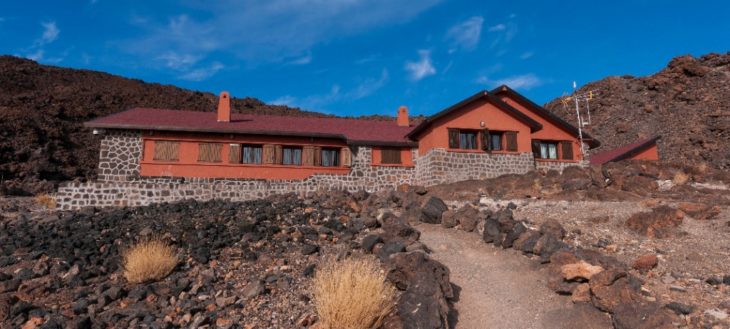 arrive at the Altavista Refuge, where we can rest. Inside we can drink water or refill the bottles, to continue on the road to Rambleta.
arrive at the Altavista Refuge, where we can rest. Inside we can drink water or refill the bottles, to continue on the road to Rambleta. - The trail ends at this point, La
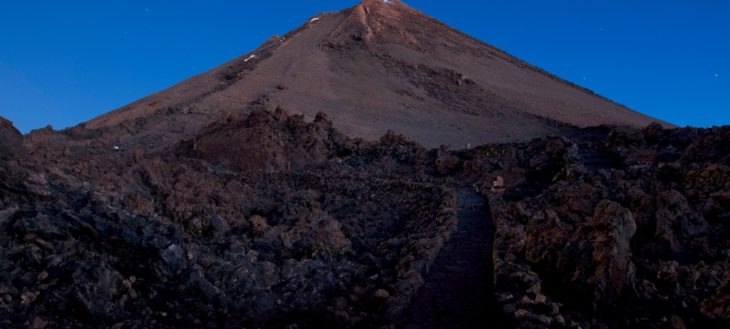 Rambleta, and on the left the Telesforo Bravo trail begins that will lead us to the peak. You can only walk through it with a special permit (see other information of interest). It is a high altitude, very steel section.
Rambleta, and on the left the Telesforo Bravo trail begins that will lead us to the peak. You can only walk through it with a special permit (see other information of interest). It is a high altitude, very steel section. - The summit is the mid point of
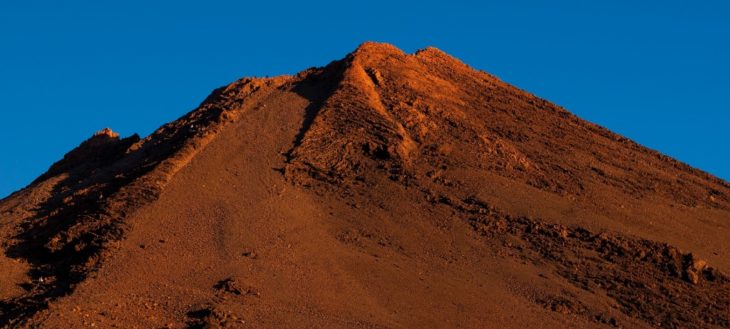 Route 040. On a clear day you can see all seven islands and large part of the island of Tenerife. Once arrived at the summit, the return journey is along the same route, only in the opposite direction, which means we have to pass the itinerary points in reverse order.
Route 040. On a clear day you can see all seven islands and large part of the island of Tenerife. Once arrived at the summit, the return journey is along the same route, only in the opposite direction, which means we have to pass the itinerary points in reverse order.
IMAGE GALLERY
- Playa del Socorro
- Casona de Castro
- Estatua del Mencey Bentor
- Mirador de La Corona
- Corral de La Vega
- Violeta del Teide (viola cheiranthifolia)
- Tajinaste (echium Wilpreti)
- Refugio de Altavista
Route video
Practical information
Data sheetTransportRecommendations
Details
| Difficulty | Difícil |
| Duration | 9:45 horas |
| Circular | Si |
| Distance | 27,19 km |
| Going up | 1,19 km (4%) |
| Going down | 16,74 km (62%) |
| Max. height | 3.676,01 mts |
| Min. height | 24,65 mts |
| Slope | 3.651,36 mts |
| Acc. drop | 7,70 mts |
BUS (http://www.titsa.com):
- Playa El Socorro: Bus line 546. (only in summer)
- El Socorro, next to TF-5 (Code 4331): Bus lines 107, 108, 363 and 325
- Montaña Blanca (Code 7687): Bus line 348
- Servitaxi Realejos: 922 346 045
- Radio Taxi: 922 346 096
PLAN AHEAD: When organising your hike, don’t forget to bring your charged mobile phone, sun protection cream, hat, adequate clothes and shoes, as well as sufficient water and food.
HIKE IN COMPANY: Before setting out, consult the meteorological conditions to make sure they are adequate. Inform family or friends about your route and only walk on marked paths.
AVOID MAKING NOISE: You will enjoy nature better in silence.
DON’T LEAVE RUBBISH: Take any rubbish with you, including anything organic and be especially careful with cigarette ends. This way you help maintain the beauty of the landscape and prevent the proliferation of rodents.
RESPECT THE ENVIRONMENT: Don’t pick plants and don’t take animals or objects from their surroundings. Respect the locals’ way of life.
BE CAREFUL: Hiking in nature holds risks. You hike under your own responsibility.
LEGAL DISCLAIMER
This leaflet is meant to be informative. The information it contains can depart from reality and cannot precisely represent the actual state of trails and paths which may have suffered alterations due to weather and other factors after this information was printed.
We remind you that adequate means and equipment have to be used for hiking and that you should always act with the necessary precaution that this activity demands.
The town hall of Los Realejos publishes this leaflet to make the trails of the municipality known to the public and does in no manner assume responsibility for its incorrect or negligent usage.


